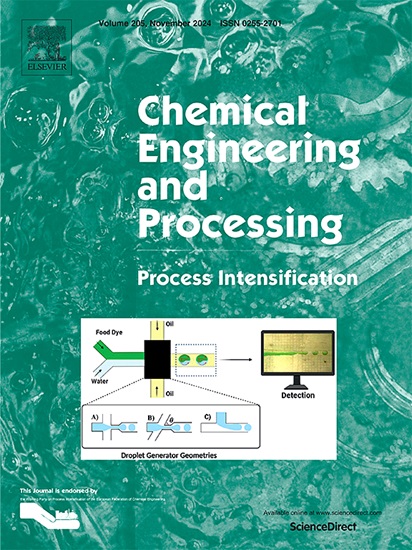氯化碱催化Cl2和CO2催化CO的配对电化学合成
IF 3.8
3区 工程技术
Q3 ENERGY & FUELS
Chemical Engineering and Processing - Process Intensification
Pub Date : 2025-02-13
DOI:10.1016/j.cep.2025.110209
引用次数: 0
摘要
为了使电化学CO2还原(eCO2R)在工业规模上具有经济可行性,可以用增值反应代替传统的析氧反应(OER)。在这项工作中,我们用氯析出反应(CER)取代OER,在CO与CO2的配对合成中。因此,在工业相关电流密度下对反应体系进行评估,并考虑电解质种类&;我们报告了在高达400 mA/cm2的条件下,恒阳极FEs对Cl2的比率为97%,在100 mA/cm2的条件下,同时FEs对CO的比率为90%,在200 mA/cm2的条件下,在4.5小时内显著超过了先前对可比系统的研究。手术24 h后,FE未见明显下降。在阴极FE和电池电位方面,KCl表现出优于NaCl和CsCl的效果。电解液浓度为0.8 mol/L,电流强度为400 mA/cm2时,FE下降到95%以下。通过在工业相关电流密度下成功将eCO2R和CER与稳定的高FEs配对,这项工作标志着向工业应用迈出了重要的一步。本文章由计算机程序翻译,如有差异,请以英文原文为准。

Paired electrochemical synthesis of Cl2 from alkali chloride and CO from CO2
In order to bring electrochemical CO2 reduction (eCO2R) to economical feasibility on an industrial scale, the conventional oxygen evolution reaction (OER) can be replaced with a value added reaction. In this work, we replace OER with chlorine evolution reaction (CER) in a paired synthesis with CO from CO2. Hereby, the reaction system is assessed at industrial relevant current densities with respect to electrolyte species & concentration and stability of up to 24 h. We report constant anodic FEs to Cl2 of 97 for up to 400 with concurrent FEs to CO of 90 at 100 and 74 at 200 over 4.5 h, significantly exceeding previous studies for comparable systems. The FE for CER did not show any decline over 24 h of operation. KCl showed superior results over NaCl and CsCl in terms of cathodic FE and cell potential. CER is affected by educt limitation with FE dropping below 95 at an electrolyte concentration of 0.8 mol/L at 400 . By successfully pairing eCO2R and CER with stable and high FEs at industrially relevant current densities, this work marks an important step towards an industrial application.
求助全文
通过发布文献求助,成功后即可免费获取论文全文。
去求助
来源期刊
CiteScore
7.80
自引率
9.30%
发文量
408
审稿时长
49 days
期刊介绍:
Chemical Engineering and Processing: Process Intensification is intended for practicing researchers in industry and academia, working in the field of Process Engineering and related to the subject of Process Intensification.Articles published in the Journal demonstrate how novel discoveries, developments and theories in the field of Process Engineering and in particular Process Intensification may be used for analysis and design of innovative equipment and processing methods with substantially improved sustainability, efficiency and environmental performance.

 求助内容:
求助内容: 应助结果提醒方式:
应助结果提醒方式:


